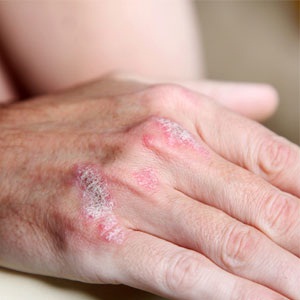
Dutch researcher Manon Franssen has shown that cells which heal the skin following an injury play an important role in the development of the skin disease psoriasis. In people with psoriasis, the skin peels much faster than normal so that it flakes and becomes inflamed.
Read: Link between psoriasis and kidney problems
Franssen investigated the transit amplifying cells in the uppermost layer of the skin. These cells develop from stem cells (general unspecialised cells) and specialise into skin cells when new skin cells are needed. The transit amplifying cells are involved in the healing of the skin following an injury and in the regular renewing of the skin.
Too many skin cells develop
Normally these cells wait until they receive a signal to develop into skin cells. Franssen discovered that in people with psoriasis, some of the transit amplifying cells divide without waiting for a signal. As a result of this, too many skin cells develop and the skin is renewed more quickly than normal.
However, when Franssen cultured the transit amplifying cells from the skin of psoriasis patients, these cells grew less quickly. Exactly how the cell division of transit amplifying cells and stem cells is regulated, is not yet clear.
In the case of psoriasis, not only is there a more rapid renewal of the skin, but the number of cell layers on the surface also increases. The skin condition causes red marks that are rich in blood and often inflamed. These red marks are covered with shiny white flakes of skin and sometimes itch. Psoriasis is not infectious.
Read: Blood made from skin
Important research area
A cure for the disease is still not available and at present only the symptoms can be controlled. According to the Dutch Psoriasis Society about 300,000 people in the Netherlands suffer from a form of this disease. Stem cell therapy might be able to provide a cure for them in the future.
Stem cells currently form an important research area in medicine. Stem cell therapy – the replacement of defective or absent stem cells, tissues or organs in patients – should be able to cure many diseases in the future.
Stem cells from the uppermost layer of the skin have never been isolated. The isolation of their descendants, the transit amplifying cells, is an important step in the right direction. By culturing these cells from patients, complete pieces of skin can be reproduced.
These are extremely useful in the treatment of burns, bedsores or skin cancer. The culturing of 'diseased' skin offers the possibility of thoroughly studying diseases and testing new treatments.
Read more:
Stem cell research: where it is at
Sun exposure ages skin
Read: Link between psoriasis and kidney problems
Franssen investigated the transit amplifying cells in the uppermost layer of the skin. These cells develop from stem cells (general unspecialised cells) and specialise into skin cells when new skin cells are needed. The transit amplifying cells are involved in the healing of the skin following an injury and in the regular renewing of the skin.
Too many skin cells develop
Normally these cells wait until they receive a signal to develop into skin cells. Franssen discovered that in people with psoriasis, some of the transit amplifying cells divide without waiting for a signal. As a result of this, too many skin cells develop and the skin is renewed more quickly than normal.
However, when Franssen cultured the transit amplifying cells from the skin of psoriasis patients, these cells grew less quickly. Exactly how the cell division of transit amplifying cells and stem cells is regulated, is not yet clear.
In the case of psoriasis, not only is there a more rapid renewal of the skin, but the number of cell layers on the surface also increases. The skin condition causes red marks that are rich in blood and often inflamed. These red marks are covered with shiny white flakes of skin and sometimes itch. Psoriasis is not infectious.
Read: Blood made from skin
Important research area
A cure for the disease is still not available and at present only the symptoms can be controlled. According to the Dutch Psoriasis Society about 300,000 people in the Netherlands suffer from a form of this disease. Stem cell therapy might be able to provide a cure for them in the future.
Stem cells currently form an important research area in medicine. Stem cell therapy – the replacement of defective or absent stem cells, tissues or organs in patients – should be able to cure many diseases in the future.
Stem cells from the uppermost layer of the skin have never been isolated. The isolation of their descendants, the transit amplifying cells, is an important step in the right direction. By culturing these cells from patients, complete pieces of skin can be reproduced.
These are extremely useful in the treatment of burns, bedsores or skin cancer. The culturing of 'diseased' skin offers the possibility of thoroughly studying diseases and testing new treatments.
Read more:
Stem cell research: where it is at
Sun exposure ages skin




 Publications
Publications
 Partners
Partners










